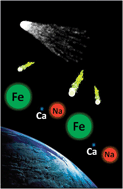This review discusses the magnitude of the cosmic dust input into the earth's atmosphere, and the resulting impacts from around 100 km to the earth's surface. Zodiacal cloud observations and measurements made with a spaceborne dust detector indicate a daily mass input of interplanetary dust particles ranging from 100 to 300 tonnes, which is in agreement with the accumulation rates of cosmic-enriched elements (Ir, Pt, Os and super-paramagnetic Fe) in polar ice cores and deep-sea sediments. In contrast, measurements in the middle atmosphere – by radar, lidar, high-flying aircraft and satellite remote sensing – indicate that the input is between 5 and 50 tonnes per day. There are two reasons why this huge discrepancy matters. First, if the upper range of estimates is correct, then vertical transport in the middle atmosphere must be considerably faster than generally believed; whereas if the lower range is correct, then our understanding of dust evolution in the solar system, and transport from the middle atmosphere to the surface, will need substantial revision. Second, cosmic dust particles enter the atmosphere at high speeds and undergo significant ablation. The resulting metals injected into the atmosphere are involved in a diverse range of phenomena, including: the formation of layers of metal atoms and ions; the nucleation of noctilucent clouds, which are a sensitive marker of climate change; impacts on stratospheric aerosols and O3 chemistry, which need to be considered against the background of a cooling stratosphere and geo-engineering plans to increase sulphate aerosol; and fertilization of the ocean with bio-available Fe, which has potential climate feedbacks.


 Please wait while we load your content...
Please wait while we load your content...